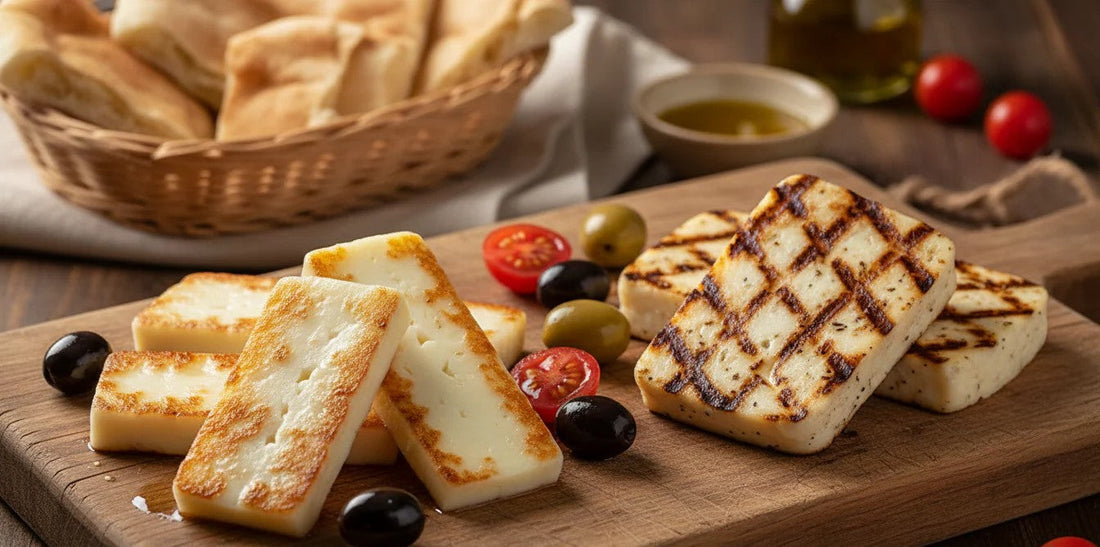Is Nabulsi Cheese the Same as Halloumi? Key Differences Explained

If you love Mediterranean and Middle Eastern food, you may have come across both Nabulsi cheese and halloumi. At first glance, they look similar — both are white, brined cheeses that can be fried or grilled without melting completely. But while they share some characteristics, they are not the same. In this guide, we’ll explain the key differences between Nabulsi cheese and halloumi, from ingredients to taste, and explore how each one is traditionally used.
What Is Nabulsi Cheese?
Nabulsi cheese comes from the city of Nablus in Palestine. It is traditionally made from sheep’s milk, sometimes mixed with goat’s milk. What makes it unique is the use of mahaleb and mastic, two aromatic spices that give the cheese its distinctive flavor. Nabulsi cheese is preserved in brine, which keeps it salty and firm, perfect for frying or baking.
When cooked, Nabulsi cheese softens and stretches slightly but doesn’t fully melt, which makes it a staple in dishes like kunafa or as a fried breakfast cheese.
What Is Halloumi?
Halloumi originates from Cyprus and is one of the most popular cheeses in Mediterranean cuisine. It is traditionally made from a mixture of sheep’s and goat’s milk, though many commercial versions also use cow’s milk. Halloumi is brined, giving it a salty flavor, and has a high melting point, which makes it suitable for grilling and frying.
Unlike Nabulsi, halloumi is not flavored with spices like mahaleb or mastic, giving it a milder, more neutral taste.
Nabulsi vs. Halloumi: Key Differences
| Aspect | Nabulsi Cheese | Halloumi Cheese |
|---|---|---|
| Origin | Nablus, Palestine | Cyprus |
| Milk Used | Mostly sheep’s milk, sometimes goat’s | Traditionally sheep + goat, often cow in modern versions |
| Flavor | Salty, aromatic with mahaleb & mastic | Salty, mild, clean taste |
| Texture | Firm, slightly stretchy when heated | Firm, squeaky, chewy |
| Cooking Uses | Frying, baking, kunafa, pastries | Grilling, frying, salads, sandwiches |
Taste Differences
One of the easiest ways to tell them apart is by flavor. Nabulsi cheese has a unique aroma and slightly herbal taste thanks to the spices used in its production. Halloumi, on the other hand, is more neutral and squeaky, making it versatile but less distinct. If you’re looking for bold, traditional flavor, Nabulsi has the edge. If you want a more subtle cheese that pairs easily with many dishes, halloumi might be your choice.
How They Are Traditionally Eaten
Nabulsi Cheese
- Fried in olive oil for breakfast with bread and olives
- Used as the star ingredient in kunafa, the famous Palestinian dessert
- Baked into pastries and pies
Halloumi Cheese
- Grilled on skewers or in sandwiches
- Fried and served with salads
- Added to wraps, burgers, or as a vegetarian meat substitute
Frequently Asked Questions (FAQ)
Can I substitute halloumi for Nabulsi cheese?
In some recipes, yes — for example, grilling or frying. But halloumi cannot replace Nabulsi in traditional Palestinian dishes like kunafa, where the flavor and texture are unique.
Which is saltier, Nabulsi or halloumi?
Both are salty, but Nabulsi often tastes saltier because of the brine and the traditional preparation process. Soaking Nabulsi in water before cooking can reduce saltiness.
Which one stretches more when cooked?
Nabulsi cheese softens and stretches slightly when heated, while halloumi maintains its firm, squeaky bite.
Which is healthier?
Both are high in protein and calcium. Nabulsi often has higher fat content due to sheep’s milk, while halloumi made with cow’s milk can be lower in fat but also less flavorful.
Final Thoughts
While Nabulsi cheese and halloumi may look alike, they are different cheeses with distinct origins, flavors, and cultural importance. Halloumi is widely known, but Nabulsi holds a special place in Palestinian cuisine and history. If you want to experience authentic Palestinian flavors, Nabulsi cheese is a must-try.
